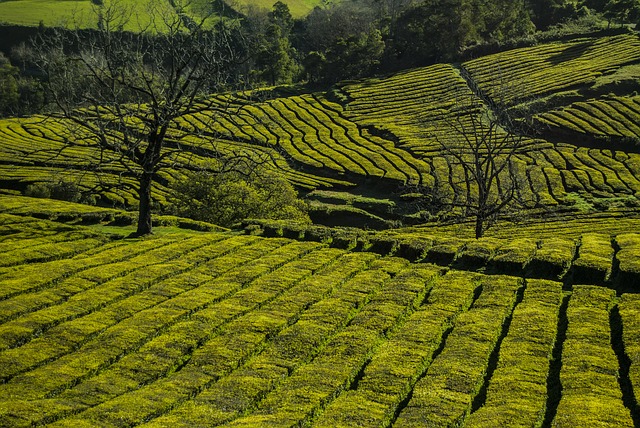Tea in the Azores
The island of São Miguel is well known for tea in the Azores. It is also home to thermal springs whose mineral-rich waters give tea an intense purple color.
At the request of a cup of “special tea” at the Chalet da Tia Mercês, Paula Aguiar, the owner, fills a transparent jug from a tap protruding from a wall of the tea house. The peculiarity is that the water being thermal comes out naturally at 60 degrees centigrade, sufficient for the preparation of this particular tea.

At the beginning, the pitcher filling routine does not reveal anything strange, but in a short time the clear water begins to turn gray, then take on the tones of lavender and finally an intense purple hue. Green tea, macerating in volcanic water, loses its natural color to also take on the same curious shade.
Reacting with green tea rich in antioxidants, the iron and non-oxidized acid content in the exceptional volcanic water causes the mixture to refract light in a different wavelength, like a prism. The minerals in the water also ensure that the tea does not become bitter, even if left to macerate for a long time.
Purple tea, however, is just one of the many wonders that this unusual group of islands has to offer.
São Miguel is one of the nine islands of the Azores archipelago. Belonging to Portugal, this group of islands in the Atlantic Ocean is located about 1500 km west of Lisbon and 3600 km from the United States. All nine islands have volcanic origins and have thermal springs, however São Miguel has some of the most extraordinary of them.
The small town of Furnas, in the eastern part of the island of São Miguel, has prehistoric hot springs and fumaroles, bubbling mud pools, multi-colored geothermal fields and rippling streams against the backdrop of green mountains with lush vegetation. Just 40 minutes from the bustling capital Ponta Delgada, visitors can venture into the volcanic valley of Furnas and feel transported to another planet.The central part of the village hosts about thirty thermal reservoirs of different temperatures and chemical compositions, most of them with mineral and iron-rich water. Many of the hot springs, reminiscent of Yellowstone, are nestled in basins with high levels of sodium bicarbonate, boron, fluorine and traces of carbon dioxide.
For centuries, locals have used water from different hot springs for various activities such as cooking, cleaning and creating herbal infusions. Other springs, on the other hand, are marked by danger signs and are fenced with rocks: some are really too hot, and the gases that come out are harmful.

Beginning in the late 1700s, the premises began to pump water directly from the sources into special bathrooms. In 1866, a wealthy businessman built one of these bath houses inside a small summer house overlooking the surrounding fumaroles.
Today, that house has become the Chalet da Tia Mercês, the home of the “purple tea”. In the back of the shop there are still two stone carved bathtubs, originally used respectively by the family of the owner of the house and another available for anyone who needs a bathroom.
The room is now full of various types of products: locally grown tea (the only two tea plantations left in Europe are both in São Miguel), São Jorge coffee, cheeses from various islands, Portuguese pastries and muffins, spirits and wines.
Nobody knows exactly when the discovery of purple tea was made, but this bizarre drink is best enjoyed together with one of Aguiar’s artisan bakery products: the chocolate and banana pudding cake that is cooked underground in one of the nearby volcanic fumaroles!








